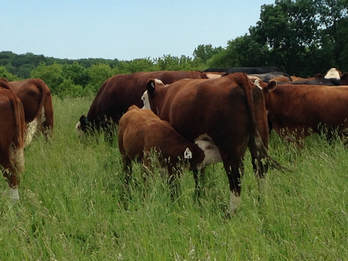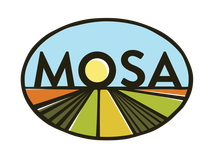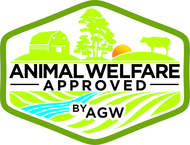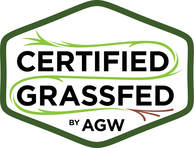|
Finishing in Fall/Winter.
This is our 9th year since buying the farm and our 6th year in operations. Every year we improve, learn, and do things better. For the last few years we have been able to narrow our calving season between April- June and our harvest season late Fall/early winter. This year we have a few harvest dates in November, most in December, and some more will be in January/February 2022 (we are only opening 2021 for now). With this in mind, we have (successfully) been working to extend our grazing season to mid December. It's been nice to see our December harvest finish in fresh grass! When grazing season is over though, we have been separating our finishers from the rest of the herd to give them a different quality feed. Our best, high carbohydrate feed goes to them (also an "all you can eat buffet"!) and we have been very successful at finishing these animals in the early winter months on grass and our best quality hay. Choose Your Processor. We use 2 processors for our beef and pork- Lake Geneva Country Meats and Wilson Farm Meats. We have good relationships with both and have been very happy with their work and service to our customers. However, we know some of you prefer one and others prefer the other, for different reasons, so we now have a "drop down" menu to select the harvest date AND processor. Keep in mind! you need to add 2-3 weeks to that harvest date to figure out when your beef will actually be ready! Request a Size. When we harvest, we usually bring 2 or more animals at a time. While we make sure our animals are well finished for processing, some animals are just genetically bigger than others. Some customers have smaller families and want less beef, and others want more, so this year we would like for you to notify us in our COMMENTS box when making your reservation if you want BIG or SMALL. When the processor gives us the hanging weights we can then try to accommodate our customers preference for more or less beef. If you have bought from us in the past, you can even let us know if you were satisfied with your last amount or want more/less. I can look back at the hanging weight you had and go from there. While this is not a guarantee, it will help us better assign harvested animals to customers based on their needs. It also may be that you are ordering a half instead of a quarter but want a "small half" so you are not overwhelmed by too much beef. Pricing Changes (Tier-pricing). We've been selling in bulk now for about 6 years with the same pricing. Unfortunately, everything else has gone up! This year, we needed to slightly increase the price per hanging weight pound, but decided to now offer "tier pricing". What this means is that if you buy a whole beef you get the same old price of $4.95/lb, for a half side beef $5.25/lb, and for a quarter side $5.50/lb. Of course, you can get creative and economical by buying with a friend, family member, or neighbor, but we request we only deal with one person for payment and communication and the processor will also get the cutting instructions from this one person, even if you are dividing it with others, so please arrange accordingly! That's it! We will work hard in the coming months to use the best grazing management for healthy grasses, healthy soil, and best finishing for our animals. Thank you for your continued support!
0 Comments
 As a mother and a health coach, one of the things you hear and read over and over is about how important breastfeeding your baby is to offer them the best nutrition possible to grow. The more I studied the subject, I learned “not all mother’s milk is created equal”. If you are eating a lot of "junk" or pesticide-filled foods, this will pass on to your child, as the quality of your milk won’t be as good. I remember when nursing our two babies, trying to eat my best for my babes! Well, the same goes for our cows. Obviously we believe grass-fed is best for cows. It is their natural diet, and it contains the healthiest fats. When it comes to milk, organic is best as well since you don’t want the toxins from chemicals and pesticides stored in its fats. We get really excited to see how grass fed, organic milk affects our herd. It really becomes apparent in the wintertime, shown in the health of our calves. These little guys and gals are chubby, growing well, active and playful, even with the cold weather we have. The milk supplies their mothers produce give them optimal health. While at some farms calves are weaned much earlier, at our farm, the calves happily nurse off their mothers for as long as nine months. This is a healthy win/win for the calf, the cow, and the consumer. We always say in our farming…. it all starts with the soil. And the best milk comes from the best grasses, which come from healthy soil. Each year we get better and better at making hay for winter-feeding from our high quality summer grasses. This quality shows up in the mother's’ milk, and on our meat. Just like in human life milk- this humble drink- is the foundation of our health, so it is for cows. It’s the most important food we receive to begin life, and we are proud of our momma cows’ milk and our very healthy calves! This blog post was a collaboration from Marisa, the health coach and mama, and Paul the farmer.  While it has felt rather “springlike” lately , we sure had a rough cold stretch here in the Midwest, starting our (official) winter season with sub zero temperatures. Many were asking me… What is winter like at the farm? Well, cold. But as far as our work and the cattle, this is what happens. Preparation In preparation for the winter, we cut and bale all our excess grasses in the summer in the form of hay for winter-feed. Also before winter hits, we give “pedicures” to all our older girls and donkeys, as we want them to have sure footing moving around in winter. We also pull out the bulls to tighten our calving season and have the cows give birth in spring/early summer on our green pastures, just as nature does it. Feeding During these months, while the cattle are still outside, once a week we set out bales of hay for a whole week out in the fields in different rows. Every day we open a fence with 4 to 5 big bales of hay in one row, cut them open and the cows move in to eat. We have “rows” like this and we move them with the electric fence. The cattle fertilizes the field with their droppings plus the wasted hay that falls out of their mouths feeds our soil life. They have access to water, salt, vitamins, minerals, sea kelp and if they so choose, shelter in the barnyard. Temperature The cattle prefer lower winter temperatures better than the real hot summer, but wind and cold rain are not a good combination, so while they are in pasture all year round, they do have access to the barns during the winter for shelter. Surprisingly to many, we rarely see them in! Our animals’ health is a concern during the winter, but our herd has been doing well as they get all the nutrition and energy they need during these cold months. The breeds of cattle we have (the English breeds) do well in our cold Midwest environment. The cattle grow a thick coat of hair that gets shed during the summer months. The calves have put on a fair amount of fat from the good milk their mothers produce, and the cows are doing well from the high quality hay they get over the winter. This layer of fat is great insulation, and is testament to our rich pastures. The Land All our grasses and plants go into hibernation. Each year we pick a different field to feed the cattle on over the winter. The field that the cattle stay on looks pretty beat up at the end of winter, but it comes back strong in the spring with all the fertility the cattle deposit during the winter months. It also gives our pastures more plant diversity as dormant seed get a chance to germinate with the open space made by the cattle’s foot activity. Other Every season there are repairs. Luckily, we only have had a few mishaps, one of the 2 water systems tripped a GFI breaker and we didn’t notice it soon enough and the system froze into a very large ice cube. The other 300-gallon tank that has a heater has performed well in this weather. Everything has been working quite smoothly this year, but we sure are looking forward to greener grasses and sunnier days! |
AuthorMarisa usually writes about nutrition, grass fed beef, organic agriculture, as well as sharing delicious recipes; Paul writes about farm work- sharing his stories and experiences, and most times... we both collaborate on the stories! Archives
March 2024
Categories
All
|
 RSS Feed
RSS Feed


